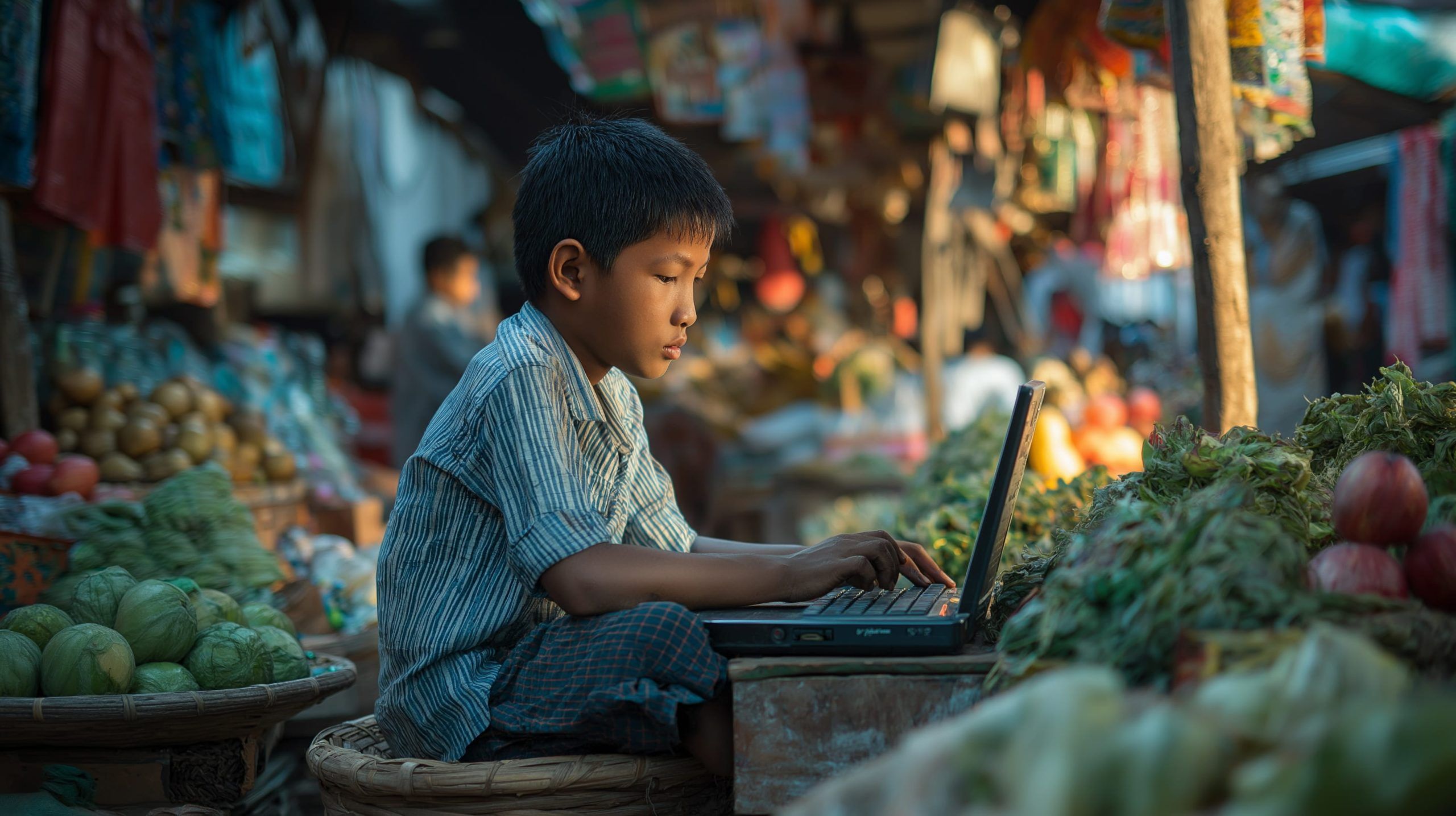- In 2021, more than 400 cell towers were destroyed amid fighting, crippling parts of Myanmar’s mobile network.
- MPT’s FTTH network expanded to 154 of 330 townships by early 2024, up from 27 townships in 2019.
- As of early 2024, Myanmar had about 64.3 million mobile connections (roughly 117% SIM penetration), with 4G coverage around 90% of the population and 5G footprint below 1%.
- By late 2024, well over 3,000 Starlink dishes were reportedly active in Myanmar, with more than 80 units confiscated in 2022.
- In December 2021 the MoTC ordered mobile operators to double data prices, and by 2023 the cost of 1 GB of mobile data was about 2,081 kyat (roughly $0.98).
- Myanmar accounted for 85 of about 300 global internet shutdowns in 2022, and in 2021 the regime imposed nightly 1am–9am internet curfews for about 70 days.
- By 2023 the four operators MPT, Atom, Ooredoo, and Mytel together held nearly 100% of mobile subscriptions and were effectively under junta sway.
- Between 2022 and 2024, more than 90 townships were completely cut off from mobile internet at various times.
- On January 1, 2025, Myanmar enacted a Cyber Security Law that mandates data localization and allows government access to user data, while unauthorized VPN use became criminal.
- Freedom House’s 2024 rankings placed Myanmar at the worst internet freedom score, tied with China.
Myanmar’s internet landscape stands at a volatile crossroads. Once celebrated for a rapid digital leap in the 2010s, the country now oscillates between forced blackouts and furtive hopes of satellite-powered connectivity. Following a 2021 military coup, Myanmar’s connectivity has been marred by infrastructure damage, government-imposed shutdowns, skyrocketing costs, and draconian censorship. Yet even as the junta tightens its grip on cyberspace, new projects like expanded fiber networks and illicit Starlink satellite links hint at possible lifelines. This report provides a comprehensive overview of internet access in Myanmar – from the state of its infrastructure and service types to provider dynamics, pricing, urban–rural divides, government controls, shutdown impacts, regional comparisons, and recent developments.
Infrastructure Status and Coverage
Myanmar’s core telecom infrastructure saw dramatic expansion after market liberalization in 2013. Today, about 44% of the population are internet users, though this penetration remains well below the Asian average of 62% [1] [2]. Mobile networks are the backbone of connectivity: 4G mobile broadband coverage reaches roughly 90% of the population, while 5G coverage is virtually nonexistent (<1%) [3]. The country is linked internationally via three undersea cables and four overland fiber gateways, providing “very good” upstream diversity for global access [4]. In theory, Myanmar’s network should be resilient.
However, ongoing civil conflict has severely strained this infrastructure. Over 400 cell towers were destroyed in 2021 amid fighting [5], and maintenance in conflict zones is perilous. The military-run Ministry of Transport and Communications (MoTC) can leverage the state-owned carrier’s assets (notably MPT’s backbone) to disrupt connectivity at will [6]. Indeed, since 2021 the junta has repeatedly cut off internet or mobile service in restive areas, especially during military operations [7]. Sagaing Region – a resistance stronghold – has endured some of the longest outages [8]. Portable signal jammers are reportedly deployed during village raids to locally sever communications [9]. Even in cities, fixed-line connections have been throttled or sporadically disrupted since 2022 [10]. Frequent electricity blackouts and fuel shortages further limit network uptime and speed, adding to infrastructure woes [11].
On a positive note, there have been investments in fiber infrastructure. State operator MPT has aggressively expanded fiber-to-the-home (FTTH) service. By early 2024, MPT’s high-speed fiber network reached 154 out of 330 townships (nearly half the country), up from just 27 townships in 2019 [12] [13]. This bundling of fixed broadband with mobile plans aims to improve urban connectivity. An independent estimate put household broadband penetration at only ~6.7% in 2023 [14] – low, but growing at ~20% annually as fiber deployments accelerate [15]. Myanmar also hosts a modest internet ecosystem with 7 active data centers and 2 Internet Exchange Points (IXPs) facilitating local traffic, though these figures lag behind regional averages [16] [17].
Table 1 – Major Connectivity Indicators (Myanmar vs. Region)
| Indicator | Myanmar | Regional Peers (examples) |
|---|---|---|
| Internet penetration (% pop) | 44% [18] [19] | ~88% in Thailand [20]; ~45% in Bangladesh [21] |
| 4G mobile coverage (% pop) | ~90% [22] | ~95% in Thailand (with 5G rolling out); ~98% in Bangladesh (4G only) |
| 5G coverage (% pop) | <1% [23] | ~major cities in Thailand; pilot stages in neighbors |
| Average mobile download speed | ~22–24 Mbps [24] [25] | ~55 Mbps in Thailand [26]; ~28 Mbps in Bangladesh [27] |
| Fixed broadband penetration | ~6.7% of households [28] [29] | ~50% in Thailand; ~7% in Bangladesh [30] |
| Freedom on Net score (2024) | 9/100 – “Not Free” [31] | 30/100 “Not Free” in Thailand; 43/100 “Partly Free” in India (for context) |
Myanmar’s internet penetration is roughly half the Asia-Pacific average, and its network quality and freedom metrics trail most neighbors. [32] [33]
Types of Internet Access: Mobile, Broadband, and Satellite
Mobile Internet is the dominant access mode for Myanmar’s 55 million people. There were 64.3 million mobile connections active as of early 2024 (a SIM penetration of ~117%) [34]. This figure actually represents a decline from 73 million in 2022, as many users abandoned secondary SIM cards post-coup to avoid surveillance or dropped service due to higher costs [35]. Still, virtually all internet users rely on mobile data services, primarily 3G/4G cellular networks. 3G and 4G networks blanket most populated areas, though in practice coverage can be weaker in remote villages and conflict zones. Notably, MPT’s mobile subscriber base of 29.6 million is split roughly “evenly between 3G and 4G”, indicating that a large share of users (often in rural or low-income groups) still use older 3G devices or networks [36]. Mobile broadband speeds in Myanmar average around 19–24 Mbps download on 4G – adequate for basic web use, but lower than speeds in neighboring countries [37]. As of 2025, 5G technology is virtually absent, unlike Thailand and Laos which have launched limited 5G in major cities. Myanmar’s first 5G trials have not materialized beyond a <1% footprint [38].
Fixed Broadband (fiber, DSL, or wireless ISP links) remains a niche but emerging sector. Only about 0.5% of total internet subscriptions were fixed-line as of 2020 [39]. Home broadband is available mainly in cities like Yangon, Mandalay, and Naypyidaw. MPT and Mytel (the military-affiliated carrier) are the leading fixed broadband providers, leveraging their fiber and LTE networks [40] [41]. Commercial fiber-to-the-home offerings have expanded recently – in early 2024, unlimited fiber plans cost around 28,000–35,000 kyat per month (≈$13–$16) for consumers [42]. These rates are far more affordable than a few years ago (the average broadband cost in Yangon fell from $72/month in 2017 to around $13–$16 by 2024 [43] [44]), reflecting increased competition and infrastructure. Alternative fixed-wireless ISPs, such as Frontiir’s “Myanmar Net”, also serve urban households with Wi-Fi hotspot networks. Nonetheless, broadband access outside major towns is very limited, and even in cities many users stick to mobile data due to its ubiquity and lower entry cost.
Satellite Internet has lately become a crucial – if officially illegal – means of connectivity in Myanmar’s hardest-hit regions. Historically, satellite links (VSAT) were used by a few businesses and remote communities, but they were expensive and tightly regulated. After the coup, the junta outright banned unlicensed satellite communications. In November 2023 the MoTC warned that any individual “providing, using or possessing” satellite internet equipment without permission would be prosecuted under telecom laws [45] [46]. Despite this, SpaceX’s Starlink – a satellite broadband service – has made inroads via clandestine channels. Starlink is not officially offered in Myanmar, but its satellite footprint spills over the region and rebel groups, civil society, and even criminal syndicates have smuggled in user terminals. By late 2024, estimates suggested “well over 3,000 Starlink dishes” were active across Myanmar [47] [48]. For communities in blackout zones, Starlink can be a lifeline: it delivers high-speed internet (50–150 Mbps) independently of terrestrial networks, enabling communication where the junta has cut off mobile service. “Starlink is now the only viable solution for instant internet” in many resistance-held or rural areas, noted one local analyst [49] [50]. Media outlets and humanitarian groups in Rakhine, Chin, Kachin and border areas have turned to Starlink to send reports and coordinate relief when other networks are down [51] [52].
That said, satellite internet in Myanmar operates in a grey zone. The equipment is very costly – several hundred dollars for the kit and a similar amount per month in service fees – and must be paid for via overseas channels due to sanctions [53]. The military has threatened to jail those caught with illicit satellite gear [54]. There is also a darker side: organized crime networks have exploited Starlink to bypass law enforcement. In scam enclaves along the Myanmar-Thailand border (e.g. Myawaddy’s casino zones), thousands of Starlink units appeared after Thai authorities cut landlines. By April 2025, over 2,492 Starlink connections were detected in just eight major scam compounds, more than double the previous year [55] [56]. The portability of the flat dish (easily smuggled in a backpack) has undermined cross-border crackdowns, prompting Thai police to plead with SpaceX to disable the service in those areas [57] [58]. In short, satellite internet in Myanmar plays a dual role – an emergency conduit for embattled civilians and rebels, but also a tool for bad actors – all while remaining officially forbidden by the regime.
Key Internet Service Providers and Market Landscape
Myanmar’s telecom market is served by a handful of key operators, all of which have seen upheaval since the coup. Table 2 summarizes the major ISPs and their reach:
Table 2 – Major Internet Service Providers in Myanmar
| Provider (Brand) | Type | Ownership / Notes | Subscriber Base (2023) |
|---|---|---|---|
| MPT (Myanma Posts & Telecom) | Mobile + Fixed (ADSL, Fiber) | State-owned (MoTC) with minority stake by Japan’s KDDI/Sumitomo [59]. Oldest carrier, extensive 3G/4G and backbone infrastructure. | 29.6 million mobile users [60]; Leading FTTH provider (154 townships) [61]. |
| Mytel | Mobile + some Fiber | Joint venture between Myanmar military (28% via MEC) and Vietnam’s Viettel (49%) [62] [63]. Launched 2018 as 4th operator, heavily military-linked. | Not disclosed officially; ~7–10 million (est.). Claimed “leading operator” by Viettel in 2023 [64], but likely ~8 million. Significant in rural areas and military networks. |
| Atom (formerly Telenor Myanmar) | Mobile (some Fixed-Wireless) | Was Norwegian-owned Telenor; sold in 2022 to M1 Group (Lebanon) & Shwe Byain Phyu (local crony firm). Renamed ATOM [65] [66]. Ownership shuffled after sanctions – now under shell company Myancom, still military-aligned [67]. | 18 million (2023) [68]. Second-largest mobile operator. Covers major cities and towns; its former foreign management exited due to junta pressure. |
| Ooredoo Myanmar | Mobile | Qatari Ooredoo entry (2014). Sold in May 2024 to Nine Communications (Singapore-based, reportedly military-linked) [69] [70]. Still operating under Ooredoo brand for now. | ~9 million (2022) [71]. Was #3 operator. Strong presence in urban areas. Foreign exit in 2024 leaves it under opaque local control. |
| Frontiir (Myanmar Net) | Fixed Wireless ISP | Private Myanmar-based ISP (U.S.-backed startup) providing Wi-Fi hotspot and home broadband in cities. Not junta-controlled. | ~0.5 million (estimated). Major provider of affordable fixed internet in Yangon/Mandalay via Wi-Fi networks. Benefited from urban demand for cheaper data. |
| Others (ISP & Satellite) | Fixed & VSAT | A few smaller ISPs (e.g., Myanmar Broadband Telecom, Yatanarpon Teleport) offer fiber, enterprise links. Legacy satellite providers (Skynet, etc.) provide VSAT for corporate use. | N/A – collectively small market share (~7% combined) [72]. Some have military ties. Satellite broadband user base is tiny but growing via Starlink (~3,000+ devices) [73]. |
Despite a facade of competition, the military’s influence permeates all major ISPs. The junta either directly owns or has leverage over each mobile operator. MPT is under the MoTC (and by extension the military government). Mytel is literally a military joint venture. The two foreign telcos (Telenor and Ooredoo) that once brought some independence have been replaced: as noted, both sold out to firms tied to the regime’s cronies [74] [75]. This consolidation allowed the junta to impose its will on operators – from forcing price hikes to complying with surveillance. By 2023, Myanmar’s telecoms market was essentially under “direct and indirect control” of the military authorities, enabling “mass censorship and surveillance” on these networks [76]. For example, all carriers must enforce strict SIM registration and were compelled to install lawful interception equipment; those that resisted faced intimidation [77] [78].
It’s worth noting the exit of foreign telecom investors as a barometer of the environment. Telenor’s withdrawal in 2022 was a high-profile example – the Norwegian company cited human rights concerns after the junta demanded access to its user data, ultimately selling to a military-linked consortium under international criticism [79] [80]. Ooredoo’s 2024 sale followed a similar pattern, with a once-major foreign stakeholder fleeing due to the hostile, sanctioned business climate [81]. Even telecom tower companies are leaving: in April 2024, Malaysia’s Axiata sought to sell its ~3,000 tower assets to a local buyer, calling Myanmar “too difficult” to operate in [82] [83]. What remains is an insular market where the top four operators (MPT, Atom, Ooredoo, Mytel) account for ~100% of mobile subscriptions [84] – and all either state-run or effectively under junta sway.
Despite this, Myanmar’s telecom sector still sees some innovation and private initiatives at the margins. The Internet Society’s “Internet Resilience” assessment gives Myanmar a score of 44%, indicating medium capacity to withstand disruptions [85]. There are two IXPs and growing local content caching (69% of popular websites reachable in-country) which improve efficiency [86]. The market had a competitive streak pre-coup – for instance, Mytel’s aggressive discounts once pushed down prices and grew its subscriber base rapidly [87]. But with the current heavy-handed regime controls, true competition has faltered. The Freedom House 2024 report notes the junta even implemented a fixed “floor pricing” for data to prevent cheaper plans, and gave Mytel special exemptions to undercut rivals early on [88] [89]. Overall, Myanmar’s ISP landscape today is less about free-market dynamics and more about political control and survival under sanctions.
Pricing, Speed, and Quality of Service
Internet service in Myanmar has become both worse and more expensive for many users since 2021. Shortly after the coup, the military authorities moved to raise prices dramatically – ostensibly to curb “excessive” internet use and stifle dissent. In December 2021, the MoTC ordered all mobile operators to double their data prices [90]. Overnight, pay-as-you-go data went from 5,000 kyat to 10,000 kyat per GB (≈$4.70) [91]. New taxes piled on: a SIM card purchase tax was introduced in 2022, telecom firms saw their corporate tax rate tripled, and even a mandatory IMEI device registration fee was levied [92]. These costs filtered down to consumers, many of whom could barely afford the sudden hikes. By early 2022, reports emerged of rural users abandoning the internet – “poorer people… reduce their usage or stop it altogether. Some have sold their devices to pay for basic needs.” [93] [94].
Although market forces and user pushback led to some adjustments (data packs eventually returned at somewhat lower rates), prices in 2023 remained roughly 27% higher than pre-coup levels on average [95]. For example, as of 2023, 1 GB of mobile data on a package cost around 2,081 kyat (≈$0.98) [96] – seemingly cheap globally, but still a burden in a country where incomes plummeted after the coup. Notably, MPT began offering “data loans” to cash-strapped users (350 MB for 859 kyat, repayable later), but at effectively higher rates that were “prohibitively expensive in Myanmar” given the economic crisis [97] [98]. The combination of inflation, unemployment, and forced price hikes has meant that internet access now consumes a larger share of household budgets. The Internet Society estimates that a basic mobile data package (1.5 GB/month) costs about 1.54% of GNI per capita in Myanmar [99]. This affordability figure is still within international benchmarks, but it masks huge urban–rural disparities. Urban middle-class users may manage, but rural villagers – with lower incomes and often needing phone credit for essential communications – find the costs punishing [100].
In terms of speed and quality, Myanmar’s networks have degraded due to both higher loads and conflict damage. Average mobile download speed fell to ~24.4 Mbps in 2023, down from earlier in the decade [101]. Fixed broadband speeds stagnated around ~19 Mbps on average [102]. These speeds are usable for most applications (emails, social media, standard-definition video), but high-bandwidth use (HD streaming, large downloads) can be challenging, especially as outages and throttling are common. Users frequently face slowdowns, particularly on fixed lines in the evenings – which some suspect is intentional throttling for surveillance or power-saving reasons [103]. Latency and stability also suffer whenever the government meddles with networks. During localized shutdowns or curfews, even users in “online” regions might experience routing issues as traffic is re-routed through limited gateways. Additionally, widespread electricity outages (a national power crisis since 2022) mean that cellular base stations and home routers often lose power, dropping connections. Power cuts have left millions offline for hours, creating a literal energy barrier to internet quality [104]. As one news outlet put it, “power shortage leaves millions without internet” when blackouts hit [105]. Those with generators or solar backups have an edge in staying connected.
On the flip side, where the infrastructure is intact and powered, Myanmar’s networks can perform reasonably well. The country adopted 4G LTE widely and even some LTE-Advanced, so users in central Yangon or Mandalay often get 30+ Mbps and low latency. The Speedtest Global Index (2024) ranked Myanmar’s mobile internet near Bangladesh’s level – median mobile speeds ~32 Mbps (Myanmar) vs ~28 Mbps (Bangladesh), though well behind Thailand’s ~55 Mbps [106] [107] [108]. For fixed broadband, the median in Myanmar (~22 Mbps) lags far below regional peers that have mass fiber (Thailand’s median fixed ~232 Mbps) [109]. The gap underscores Myanmar’s limited fiber penetration and older ADSL still in use.
Quality of service also diverges between providers. Privately, users note that MPT’s network, while broad, often suffers congestion and uses older infrastructure, whereas Mytel (backed by Viettel) introduced more modern equipment and sometimes offers faster data in areas where it built new towers. However, Mytel’s association with the military led many to boycott it, and some have reported it prioritizes military usage, which could affect public QoS [110]. Customer service quality has declined too – with foreign staff gone, telecom customer support and technical maintenance have reportedly become less responsive, hampered by the broader brain drain and chaos.
In summary, Myanmar’s internet is slower, costlier, and less reliable than it was a few years ago, hitting the poor and rural hardest. As one Al Jazeera piece aptly titled in 2022, “Myanmar’s internet gets pricier for dissenters, apolitical alike” – everyone is paying more for a deteriorating service [111]. This dynamic risks widening the digital divide and pushing people offline, precisely when information access is most critical.
Urban vs. Rural Access Disparity
A stark digital divide persists (and in some ways, widens) between Myanmar’s urban centers and its rural, remote areas. On paper, telecom operators have achieved high population coverage – over 90% of the population lived under a mobile network signal by 2020, thanks to tower rollouts even in many villages [112] [113]. But coverage is not the same as connectivity. Rural users face multiple hurdles: lack of infrastructure, higher relative costs, and, since the coup, deliberate connectivity blackouts in certain regions.
In cities like Yangon, Mandalay, and Naypyidaw, residents can choose between multiple 4G networks, home broadband providers, and public Wi-Fi. Urban literacy and digital literacy rates are higher, and more people own smartphones. It’s not uncommon for a city dweller to stream YouTube or use video calls (when the internet isn’t shut off). Indeed, fiber-to-the-home expansions in 2023–24 primarily benefited urban neighborhoods – MPT’s FTTH now covers parts of all major cities [114] [115]. Furthermore, gender and social gaps in internet use, while still present, have narrowed more in cities where awareness and education efforts reach women and disadvantaged groups [116]. Urban women cite cost and perceived irrelevance as barriers, but initiatives pre-coup had begun addressing these [117].
Contrast this with rural Myanmar. In many villages, especially in hilly border states, mobile coverage might come from a single tower (often MPT or Mytel) offering only 2G voice or basic 3G data. Electricity in such areas is sporadic, so residents often must charge phones at generator shops. When the junta began raising data tariffs, rural communities were hit hardest: unlike some city folk who could absorb or workaround costs, rural users often had to give up data-heavy internet use entirely [118]. Media reports noted that in villages, people stopped watching online videos or Facebook Live updates due to data costs, switching to text-only Telegram channels or SMS for news [119]. This reduction in access to rich information (e.g. educational videos, telehealth consultations, etc.) is widening the knowledge gap between urban and rural populations.
Moreover, the junta’s security-driven shutdowns have disproportionately affected rural and ethnic minority regions. Over 90 townships – many rural – have been cut off from mobile internet at various points during 2022–2024 [120]. These include large swathes of Sagaing, Chin, Kachin, Kayah, and parts of Rakhine and Karen (Kayin) States [121] [122]. Often, these are farming communities or small towns that suddenly find themselves in a digital blackout for weeks or months on end. Urban Myanmar has seen censorship and occasional nightly curfews on the net, but nothing like the “information siege” imposed on conflict-hit rural zones. One chilling impact: in May 2024, locals in Pauk township (Magway) couldn’t call ambulances or firefighters during an airstrike-induced blaze because the mobile network was shut off – raising the risk of casualties from secondary effects like fires [123] [124]. In another case, during an offensive in Rakhine, the military not only cut internet but even cut electricity to towns like Thandwe, literally plunging residents into darkness and silence [125] [126].
Even where the internet isn’t deliberately blocked, rural areas suffer from slower expansion of infrastructure. The Universal Service Fund (USF) that was meant to subsidize rural telecom projects (targeting 99% service coverage by 2022) was redirected by the junta in late 2022 toward surveillance projects (a SIM registration database), rather than building rural towers [127] [128]. As a result, the incentives to reach the last 10% of the population evaporated. Some ethnic regions took matters into their own hands – for instance, local groups in Chin State reportedly erected improvised telecom towers to get coverage, only to have the military destroy these and threaten imprisonment for such unauthorized infrastructure [129]. This exemplifies how in rural conflict zones, community-driven connectivity efforts are actively sabotaged by the regime.
All these factors mean that urban residents enjoy relatively better connectivity options and continuity, whereas rural and especially conflict-zone populations endure a communications vacuum. This divide has severe implications: rural people are often those who need critical information the most (for example, warnings about military movements or natural disasters). During the devastating Cyclone Mocha in 2023, some villages in Chin and Rakhine did not receive timely storm warnings “due to communication difficulties”, as the internet and phone lines were down [130]. The digital divide in Myanmar is thus not just about economic opportunity, but a literal life-and-death concern in some cases.
Government Regulations and Censorship
Myanmar’s government (currently the military junta) exercises tight control over the internet, implementing a regime of censorship, surveillance, and legal restrictions that Freedom House ranks among the most repressive in the world [131] [132]. Since the February 2021 coup, the junta has systematically “built a mass censorship and surveillance regime” [133] to monitor and silence dissent online. Key aspects of this control include:
- Website and Platform Blocking: The junta wastes no time in blocking platforms deemed threatening. Within days of the coup, they blocked Facebook – by far Myanmar’s most popular social media – along with WhatsApp and Instagram [134] [135]. Twitter (now X) was also blocked by early February 2021 [136]. Since then, the list has expanded. As of mid-2024 the government was actively restricting WhatsApp, X (Twitter), Instagram (again, after briefly unblocking some in 2021) [137], and it had blocked most independent media websites and even Wikipedia [138]. Essentially, any online source of uncensored news or large-scale communication has been targeted. The approach has been both broad and iterative: some platforms were whitelisted or unblocked temporarily as “honeypots” (e.g. Tinder and Viber were left accessible for a time) [139], but by May 2024 the junta slammed the door again, issuing orders to block or throttle nearly all major social apps and VPN services [140] [141].
- VPN Ban and Surveillance: For a while, users circumvented censorship via Virtual Private Networks. VPN usage became widespread post-coup – one secure messaging app (Bridgefy) saw over a million downloads in Myanmar within two days of the coup, reflecting the population’s turn to circumvention tools [142]. In response, the junta first tried to block popular VPN servers; then in January 2025 it went further and criminalized VPN usage outright. Under a new Cyber Security Law (enacted January 1, 2025), simply having an unauthorized VPN installed can lead to 6 months in prison and fines [143]. By mid-2024, police were conducting physical phone searches for VPN apps – “arresting and fining those found to have VPN apps on their devices” [144]. This has driven many users offline or into deeper secrecy. The regime also expanded its surveillance toolkit: telecom companies are required to install intercept technology capable of monitoring calls, messages, and internet traffic [145] [146]. Leaked documents (e.g., from Telenor) showed the military pressured telcos for “lawful interception” capabilities even before the coup, and after seizing power they have full access. Reports indicate the authorities monitor social media to geolocate and arrest dissidents – numerous cases exist of Facebook posts or online comments leading to midnight knocks on the door [147] [148]. Scores of internet users have been imprisoned for online speech, some handed multi-year sentences by military courts simply for anti-coup Facebook posts [149].
- Mandatory SIM and ID Registration: Anonymity in Myanmar’s telecom space has been virtually eliminated. Even before 2021, SIM card registration with an ID was technically required, but enforcement was lax. Now the junta enforces it rigorously – all SIMs must be tied to a citizen’s National Registration Card or new digital ID. In mid-2022 the regime rolled out a centralized SIM Registration Management System (funded by repurposing the USF) to compile citizens’ mobile identities [150]. There are even moves to link SIM registration with biometric data or the new “UID” (digital Unique ID) system [151] [152]. In effect, every mobile internet user is known to the state, making it easier to police online activity. The chilling effect is palpable: people fear that any controversial message can be traced back to them via their SIM, especially given reports that Telenor’s historical customer data might have ended up in military hands during the takeover [153].
- Draconian Laws (Cybersecurity Bill): The junta drafted a sweeping Cyber Security Law in 2022 (still officially a “draft” by late 2024) that codifies many repressive measures. The draft law would require online platforms and ISPs to remove any content the authorities deem undesirable and hand over user data on demand [154]. It mandates that any platform with over 100,000 users in Myanmar must store data on local servers accessible to the military (a de facto data localization requirement) [155]. Noncompliant tech companies could face bans or criminal charges against their local staff [156]. As an example of enforcement, when Facebook refused to establish a local office or fully comply, the junta simply blocked it and sought to arrest any proxy representatives they could find [157] [158]. The digital economy has thus stalled under uncertainty – even local e-commerce sites operate in fear of running afoul of vague new rules, and foreign tech companies (aside from Chinese firms) have largely frozen or exited operations. The U.S. State Department noted that inconsistent enforcement and a lack of transparent laws – coupled with internet restrictions – have created a very challenging digital business environment in Myanmar [159].
- Propaganda and Alternative Platforms: In tandem with censorship, the military deploys propaganda and tries to steer users to regime-controlled services. In 2023, the Ministry of Information launched “MTube”, a YouTube knock-off meant to host state-produced videos and serve as a sanitized video platform [160]. The junta also promotes a social network called “OKPar”, positioned as a Facebook alternative that (unsurprisingly) bans any content critical of the regime [161]. While these attempts have had limited success (users find them clunky and unappealing), they reflect the regime’s desire to create a controlled digital ecosystem. Additionally, pro-military trolls and bot accounts flood real social media with disinformation. The military is believed to run large troll farms that harass dissidents online and spread narratives labeling the resistance as “terrorists” [162]. This online information warfare, combined with strict censorship, means Myanmar’s internet is bifurcated: inside the country people see only state-approved narratives (unless they risk using a VPN), while outside information struggles to reach the public.
In summary, Myanmar’s government has effectively stood up a digital dictatorship. The legal and technical controls in place mirror or even exceed those in countries like China – indeed Myanmar tied China for the worst internet freedom score in Freedom House’s 2024 rankings [163] [164]. The populace, which had tasted a relatively open internet in the late 2010s (Myanmar was “Partly Free” in 2014 by Freedom House scoring) [165], has been thrust into an environment of heavy-handed censorship overnight. Resistance is still evident – many citizens use web proxies, covert internet connections, or simply share banned news peer-to-peer – but the risks are high. The National Unity Government (NUG) in exile has condemned the junta’s digital repression and even vowed to “build an independent internet network in places free from military control” [166]. In practice, this might involve community networks or satellite links in liberated areas. Until that materializes, however, the junta maintains a formidable grip on the flow of information.
Internet Shutdowns and Political Impact
One of the most extreme tactics the Myanmar junta has employed is internet shutdowns – from nationwide blackouts to targeted local outages. These shutdowns have had profound political and humanitarian consequences. In 2022, Myanmar infamously ranked as the world’s leading perpetrator of internet shutdowns, accounting for 85 out of nearly 300 shutdown incidents recorded globally that year [167] [168]. The trend continued through 2023 and 2024, making Myanmar a tragic fixture in Access Now’s annual “KeepItOn” reports.
Right at the start of the coup on February 1, 2021, the military demonstrated its willingness to pull the plug on connectivity. Troops occupied data centers and switch rooms in the early hours and shut off the national internet for a period, to preempt resistance coordination [169]. In subsequent weeks, the regime imposed recurring nightly internet curfews – cutting off mobile data nationwide from 1am to 9am for about 70 days straight, ostensibly to “maintain stability” [170]. Although full nationwide shutdowns eased by mid-2021, the junta pivoted to a more selective strategy: localized shutdowns in regions of active resistance [171]. Essentially, whenever clashes intensify in a certain area, or before a major military operation, the authorities disable internet (and often phone service) in that locality. As of early 2025, this tactic has only grown – “the war-torn country suffered more shutdowns in 2024 than any other place in the world”, mostly imposed by the embattled junta [172] [173].
The impact on the ground is devastating. These shutdowns often coincide with or precede harsh crackdowns and atrocities by the military. A 2024 Access Now study found “31 shutdowns coincided with documented grave human rights abuses” such as massacres or airstrikes on civilians, suggesting the military uses blackouts to hide its operations from both local and international eyes [174] [175]. Civilians under air raid threat rely on the internet for warnings – as one analyst put it, “information is now life or death… An internet blackout effectively blinds these communities, making them sitting targets” [176] [177]. For example, residents in resistance-held areas often watch Facebook or Telegram channels that track troop movements; when the net is cut, they have no alert for incoming attacks. This has cost lives. Aid groups reported that during an earthquake in April 2025 in Chin State, ongoing shutdowns hindered relief efforts – rescuers couldn’t communicate, and victims couldn’t call for help [178] [179].
Economically, shutdowns have also exacted a toll. An estimate by the Internet Society suggests each day of national internet shutdown costs Myanmar around $458,000 in GDP losses [180]. Cumulatively, given the numerous days and regions affected, this amounts to millions drained from an already fragile economy. Businesses in blackout areas (banks, shops, farms) are cut off from markets and information. The frequent disruption has damaged investor confidence – even local entrepreneurs hesitate to rely on online services knowing they could be dark at any moment.
Politically, the shutdowns are a blunt instrument to control the narrative and isolate opposition strongholds. The junta’s intention, as analysts note, is to “disempower people in Myanmar” by cutting their communication [181]. Junta officials continue to claim, unconvincingly, that outages are for “security” or to prevent “fake news” [182]. In reality, it prevents reports of the junta’s own actions from getting out. One veteran journalist said it plainly: “They [the military] make sure there is no independent access to information… so most people can’t access independent news, especially young people” [183]. Thus, shutdowns not only hamper the resistance’s coordination, but also create an information vacuum in which state propaganda can dominate.
Regions particularly affected include Sagaing (central Myanmar) – large parts of which have been in an “internet blackout” for months at a time since 2022 [184]; Chin and parts of Kachin – often cut off amid offensives; Rakhine (Arakan) – where during late 2022 a shutdown coincided with fighting against the Arakan Army [185]; and border towns like Kokang Self-Administered Zone – where even Chinese authorities have leaned in, at one point China itself initiated cross-border shutdowns in areas adjacent to its border for security [186]. The patchwork nature of connectivity has led to a surreal situation: some townships enjoy normal internet, while the next township over might be a digital black hole. About a quarter of Myanmar’s 330 townships were completely cut off to internet as of late 2024, according to one local monitoring group [187] [188].
To cope, civilians and resistance groups have shown ingenuity. Many smuggle news on USB drives in and out of blackout zones. As noted earlier, Starlink satellite units are deployed in some liberated pockets specifically to circumvent the shutdowns. Ethnic armed organizations sometimes set up their own mobile networks or microwave links to border countries for communication – essentially building parallel connectivity where the state destroyed it. The exiled NUG government has lobbied for international support to extend internet via satellite or cross-border telecom to resistance areas. These efforts remain nascent, but they underscore that information access is now seen as critical infrastructure in the conflict, as important as roads or supply lines.
In the wider region, Myanmar’s internet shutdown strategy has drawn condemnation. It stands in contrast to neighboring countries: while some neighbors like India or Bangladesh have at times shut down internet in specific regions for security, Myanmar’s frequency and breadth of shutdowns in 2022–2024 are unparalleled in Southeast Asia. The U.N. and ASEAN have raised concerns about the humanitarian impact of prolonged communications blackouts. All said, internet shutdowns have become both a weapon and a hallmark of the Myanmar junta’s rule, with dire consequences for the country’s people and their ability to stay informed and safe.
Recent Developments and Future Outlook
Despite the bleak situation, recent developments hint at both positive and negative changes in Myanmar’s internet landscape:
- Starlink Aid and “Dreams”: In a surprising turn, SpaceX’s Starlink drew international attention in early 2025 when Elon Musk offered to provide Starlink kits to Myanmar for disaster relief after a major earthquake [189]. While Myanmar’s regime would likely reject official offers (given Starlink is unlicensed), this move signaled growing global awareness that satellite internet could help Myanmar’s populace. It feeds into what some call “Starlink dreams” – the hope that one day uncensored satellite internet might be openly available, reconnecting Myanmar’s people to the world regardless of the junta. For now, those dreams are tempered by reality: the military continues to seize smuggled Starlink units (over 80 Starlink devices were confiscated by authorities in 2022 in Myanmar and Thailand) [190], and the U.S. has even considered blocking Starlink use in certain criminal hotspots [191]. Still, the mere presence of thousands of clandestine terminals means the genie is out of the bottle – the junta may find it increasingly difficult to enforce a complete digital isolation as long as small satellite dishes can beam information in and out.
- Fiber and 5G Ambitions: On the infrastructure front, Myanmar’s telecom companies have quietly continued upgrades where possible. MPT’s massive FTTH rollout to half the townships is one example [192]. There are reports that 5G trials could restart if the political climate stabilizes – for instance, Mytel and Huawei had pre-coup plans for 5G pilots. However, Western sanctions on telecom equipment and capital flight have slowed any 5G progress. Neighboring countries moving ahead with 5G might eventually spur Myanmar’s operators to follow suit to stay regionally competitive, but this likely hinges on political resolution. In the interim, we might see more investment in 4G LTE-Advanced to improve speeds, and possibly expansion of fiber backhaul in secondary cities. Notably, neighboring Thailand and India have extended some fiber connectivity to Myanmar’s border, which could facilitate future cross-border internet exchange if relations improve or in humanitarian scenarios.
- Regulatory Changes: The junta’s Cyber Security Law (2024) is expected to be fully implemented, which will formalize the tight controls on content and data. We may see periodic “internet amnesties” announced – for example, in mid-2025 the junta floated that it might allow certain social media back if they comply with censorship (similar to how they briefly unblocked some sites in 2021 before re-blocking). In essence, regulations will likely oscillate between carrots and sticks to manage public sentiment. The regime could also explore controlled internet reopening in some areas if it believes it has technological means to filter content (for instance, a nationwide firewall or whitelisting system). There was talk of a “national internet gateway” law akin to China’s Great Firewall – indeed, Myanmar was planning to route traffic through a single gateway in 2021 before widespread resistance shelved it [193] [194]. That plan might resurface, enabling more granular control instead of blunt shutdowns.
- Digital Economy and Projects: Interestingly, Myanmar’s Ministry of Transport and Communications has drafted a Digital Economy Roadmap 2030, expected to be finalized by 2025 [195] [196]. This roadmap (developed likely to show a forward-looking face) includes infrastructure development, promotion of e-commerce, fintech, and digital literacy. If implemented earnestly, it could drive projects like rural telecom expansion, startup incubation, and e-government services. However, much of this appears aspirational under the weight of sanctions and conflict. The roadmap’s fate may depend on political reconciliation – a stable environment is needed to attract investment for such projects. Until then, progress will be limited. One concrete step: in mid-2024, the Central Bank increased digital payment transaction limits, a small sign of encouraging fintech growth despite everything [197].
- Neighboring Country Comparisons: Looking outward, Myanmar’s lag becomes more pronounced each year it remains under isolation. Thailand, for instance, now boasts widespread 5G in Bangkok and plans for smart cities, while Myanmar is stuck on 4G. Bangladesh, with a comparable GDP per capita, has edged to similar internet penetration (~45%) but in a far more stable upward trend [198]. Vietnam (not a direct neighbor but a regional peer) has ~75% internet penetration and heavily invests in tech, including its military-owned Viettel (Mytel’s parent) which may quietly keep Mytel in Myanmar upgraded to protect its investment [199]. India and China both deploy cross-border fiber and may influence Myanmar’s future connectivity – India’s state companies had a project to link Myanmar to its national knowledge network, and China’s Belt and Road includes telecom components in Myanmar (though those have stalled due to instability) [200]. In terms of freedom, Myanmar joining China at the bottom of internet freedom rankings in 2024 is telling [201]. Without changes, Myanmar risks becoming an isolated intranet like North Korea’s – a dire comparison few imagined a decade ago.
In conclusion, Myanmar’s internet saga is a pendulum of setbacks and resilience. On one side: infrastructure lies damaged but not destroyed, people are censored but not completely silenced, and the junta wields disconnection as a weapon. On the other side: users find new paths to reconnect – be it through illicit satellite kits, cross-border SIM cards from Thailand, or old-school offline sharing. Recent moves like Starlink deployments, fiber network growth, and even the regime’s own digital economy plans suggest that the story isn’t static. Myanmar’s internet dilemma – caught between blackouts and dreams of unfettered access – will likely continue, shaped by the broader political fate of the nation. A truly open, high-quality internet in Myanmar ultimately hinges on peace and governance that prioritizes connectivity as a public good rather than a threat. Until then, Myanmar’s netizens will keep navigating the darkness in search of light online.
Sources:
- Internet Society Pulse – Myanmar Country Report Highlights [202] [203]
- Freedom House – Freedom on the Net 2024: Myanmar (Key Developments) [204] [205]
- Freedom House – Freedom on the Net 2024: Obstacles to Access (A1, A2) [206] [207]
- Freedom House – Freedom on the Net 2024: Govt Control of Infrastructure (A3) [208] [209]
- Freedom House – Freedom on the Net 2024: Service Providers and Ownership (A4) [210] [211]
- Mobile World Live – “MPT takes FTTH footprint to half of Myanmar” (Feb 2024) [212] [213]
- DW News – “Myanmar: Why is junta shutting down internet?” (Feb 27, 2025) [214] [215]
- VOA News – “Myanmar’s internet blackouts drive rebels, medics, scammers to satellite service” (Nov 17, 2024) [216] [217]
- Nation Thailand – “Myanmar Scammers Adopt Starlink to Evade Blackouts” (July 21, 2025) [218] [219]
- EngageMedia – Myanmar Digital Coup Quarterly (May–July 2024) [220] [221]
- IP Defense Forum – “Internet access plummets in Myanmar, report finds” (Nov 9, 2024) [222] [223]
- International Trade Administration – Burma Digital Economy, Market Challenges (Sept 2024) [224] [225]
References
1. pulse.internetsociety.org, 2. pulse.internetsociety.org, 3. pulse.internetsociety.org, 4. freedomhouse.org, 5. freedomhouse.org, 6. freedomhouse.org, 7. freedomhouse.org, 8. freedomhouse.org, 9. freedomhouse.org, 10. freedomhouse.org, 11. www.trade.gov, 12. www.mobileworldlive.com, 13. www.mobileworldlive.com, 14. www.mobileworldlive.com, 15. www.mobileworldlive.com, 16. pulse.internetsociety.org, 17. pulse.internetsociety.org, 18. pulse.internetsociety.org, 19. pulse.internetsociety.org, 20. datareportal.com, 21. tradingeconomics.com, 22. pulse.internetsociety.org, 23. pulse.internetsociety.org, 24. pulse.internetsociety.org, 25. freedomhouse.org, 26. worldpopulationreview.com, 27. worldpopulationreview.com, 28. freedomhouse.org, 29. www.mobileworldlive.com, 30. www.wicinternet.org, 31. freedomhouse.org, 32. pulse.internetsociety.org, 33. www.dw.com, 34. freedomhouse.org, 35. freedomhouse.org, 36. www.mobileworldlive.com, 37. freedomhouse.org, 38. pulse.internetsociety.org, 39. freedomhouse.org, 40. freedomhouse.org, 41. freedomhouse.org, 42. freedomhouse.org, 43. freedomhouse.org, 44. freedomhouse.org, 45. www.nationthailand.com, 46. www.nationthailand.com, 47. www.voanews.com, 48. www.voanews.com, 49. www.voanews.com, 50. www.voanews.com, 51. www.dw.com, 52. www.dw.com, 53. freedomhouse.org, 54. freedomhouse.org, 55. www.nationthailand.com, 56. www.nationthailand.com, 57. www.nationthailand.com, 58. www.nationthailand.com, 59. freedomhouse.org, 60. freedomhouse.org, 61. www.mobileworldlive.com, 62. en.wikipedia.org, 63. en.wikipedia.org, 64. freedomhouse.org, 65. freedomhouse.org, 66. freedomhouse.org, 67. freedomhouse.org, 68. freedomhouse.org, 69. freedomhouse.org, 70. freedomhouse.org, 71. freedomhouse.org, 72. pulse.internetsociety.org, 73. www.voanews.com, 74. freedomhouse.org, 75. freedomhouse.org, 76. freedomhouse.org, 77. freedomhouse.org, 78. freedomhouse.org, 79. freedomhouse.org, 80. freedomhouse.org, 81. freedomhouse.org, 82. freedomhouse.org, 83. freedomhouse.org, 84. uk.finance.yahoo.com, 85. pulse.internetsociety.org, 86. pulse.internetsociety.org, 87. en.wikipedia.org, 88. en.wikipedia.org, 89. en.wikipedia.org, 90. freedomhouse.org, 91. freedomhouse.org, 92. freedomhouse.org, 93. freedomhouse.org, 94. freedomhouse.org, 95. freedomhouse.org, 96. freedomhouse.org, 97. freedomhouse.org, 98. freedomhouse.org, 99. pulse.internetsociety.org, 100. freedomhouse.org, 101. freedomhouse.org, 102. freedomhouse.org, 103. freedomhouse.org, 104. freedomhouse.org, 105. freedomhouse.org, 106. worldpopulationreview.com, 107. worldpopulationreview.com, 108. worldpopulationreview.com, 109. worldpopulationreview.com, 110. en.wikipedia.org, 111. freedomhouse.org, 112. www.ptd.gov.mm, 113. www.ptd.gov.mm, 114. www.mobileworldlive.com, 115. www.mobileworldlive.com, 116. freedomhouse.org, 117. freedomhouse.org, 118. freedomhouse.org, 119. freedomhouse.org, 120. engagemedia.org, 121. freedomhouse.org, 122. freedomhouse.org, 123. engagemedia.org, 124. engagemedia.org, 125. engagemedia.org, 126. engagemedia.org, 127. freedomhouse.org, 128. freedomhouse.org, 129. freedomhouse.org, 130. freedomhouse.org, 131. freedomhouse.org, 132. ipdefenseforum.com, 133. ipdefenseforum.com, 134. freedomhouse.org, 135. freedomhouse.org, 136. freedomhouse.org, 137. freedomhouse.org, 138. freedomhouse.org, 139. freedomhouse.org, 140. freedomhouse.org, 141. freedomhouse.org, 142. freedomhouse.org, 143. www.dw.com, 144. freedomhouse.org, 145. freedomhouse.org, 146. freedomhouse.org, 147. freedomhouse.org, 148. ipdefenseforum.com, 149. freedomhouse.org, 150. freedomhouse.org, 151. engagemedia.org, 152. engagemedia.org, 153. freedomhouse.org, 154. freedomhouse.org, 155. freedomhouse.org, 156. freedomhouse.org, 157. freedomhouse.org, 158. freedomhouse.org, 159. www.trade.gov, 160. freedomhouse.org, 161. freedomhouse.org, 162. freedomhouse.org, 163. ipdefenseforum.com, 164. ipdefenseforum.com, 165. ipdefenseforum.com, 166. ipdefenseforum.com, 167. www.dw.com, 168. www.dw.com, 169. freedomhouse.org, 170. www.dw.com, 171. freedomhouse.org, 172. www.dw.com, 173. www.dw.com, 174. www.dw.com, 175. www.dw.com, 176. www.dw.com, 177. www.dw.com, 178. pulse.internetsociety.org, 179. pulse.internetsociety.org, 180. pulse.internetsociety.org, 181. www.dw.com, 182. www.dw.com, 183. www.dw.com, 184. freedomhouse.org, 185. freedomhouse.org, 186. www.dw.com, 187. www.voanews.com, 188. www.voanews.com, 189. www.techinasia.com, 190. www.malaymail.com, 191. www.nationthailand.com, 192. www.mobileworldlive.com, 193. freedomhouse.org, 194. freedomhouse.org, 195. www.trade.gov, 196. www.trade.gov, 197. www.trade.gov, 198. tradingeconomics.com, 199. freedomhouse.org, 200. ipdefenseforum.com, 201. ipdefenseforum.com, 202. pulse.internetsociety.org, 203. pulse.internetsociety.org, 204. freedomhouse.org, 205. freedomhouse.org, 206. freedomhouse.org, 207. freedomhouse.org, 208. freedomhouse.org, 209. freedomhouse.org, 210. freedomhouse.org, 211. freedomhouse.org, 212. www.mobileworldlive.com, 213. www.mobileworldlive.com, 214. www.dw.com, 215. www.dw.com, 216. www.voanews.com, 217. www.voanews.com, 218. www.nationthailand.com, 219. www.nationthailand.com, 220. engagemedia.org, 221. engagemedia.org, 222. ipdefenseforum.com, 223. ipdefenseforum.com, 224. www.trade.gov, 225. www.trade.gov










